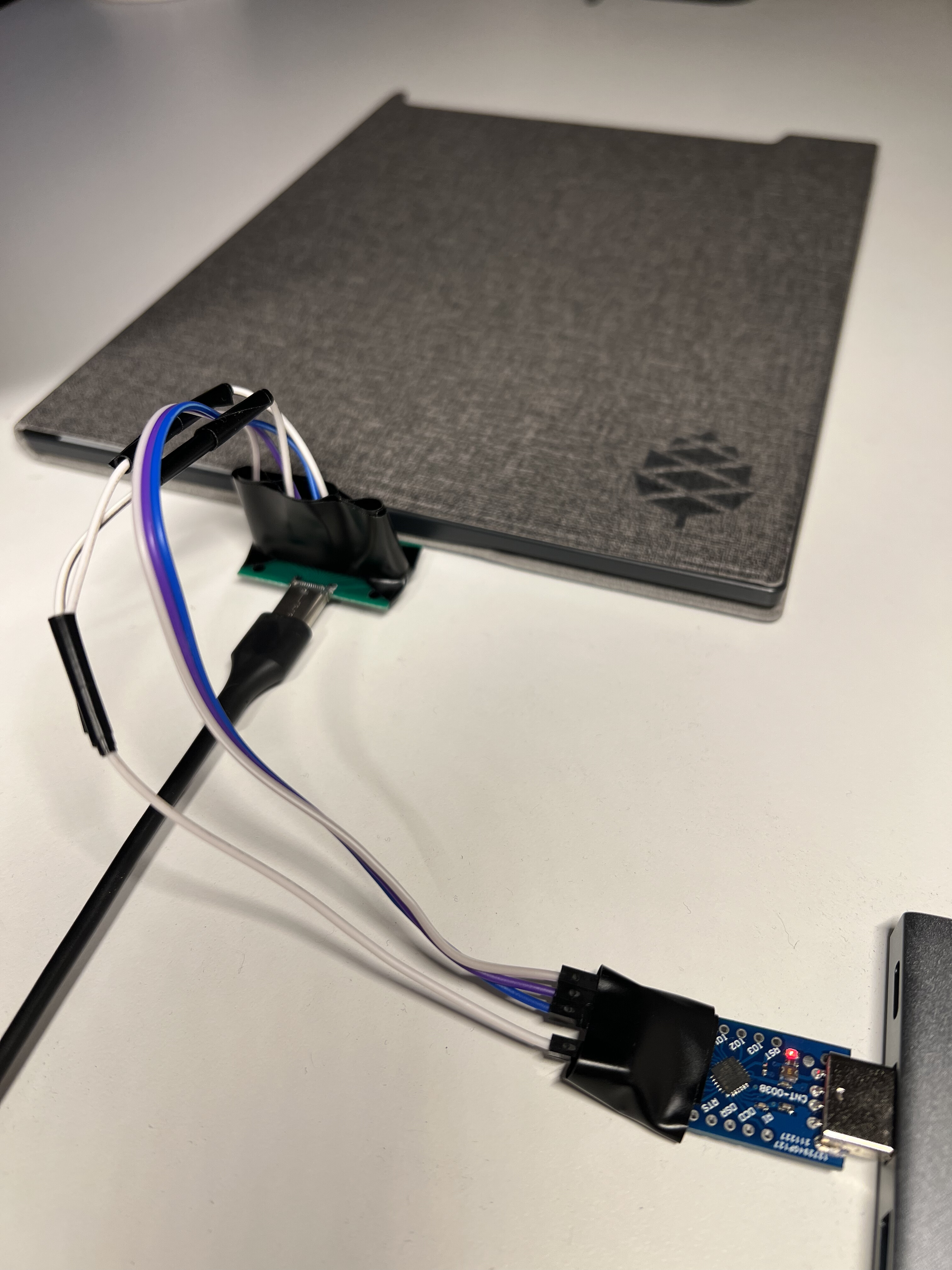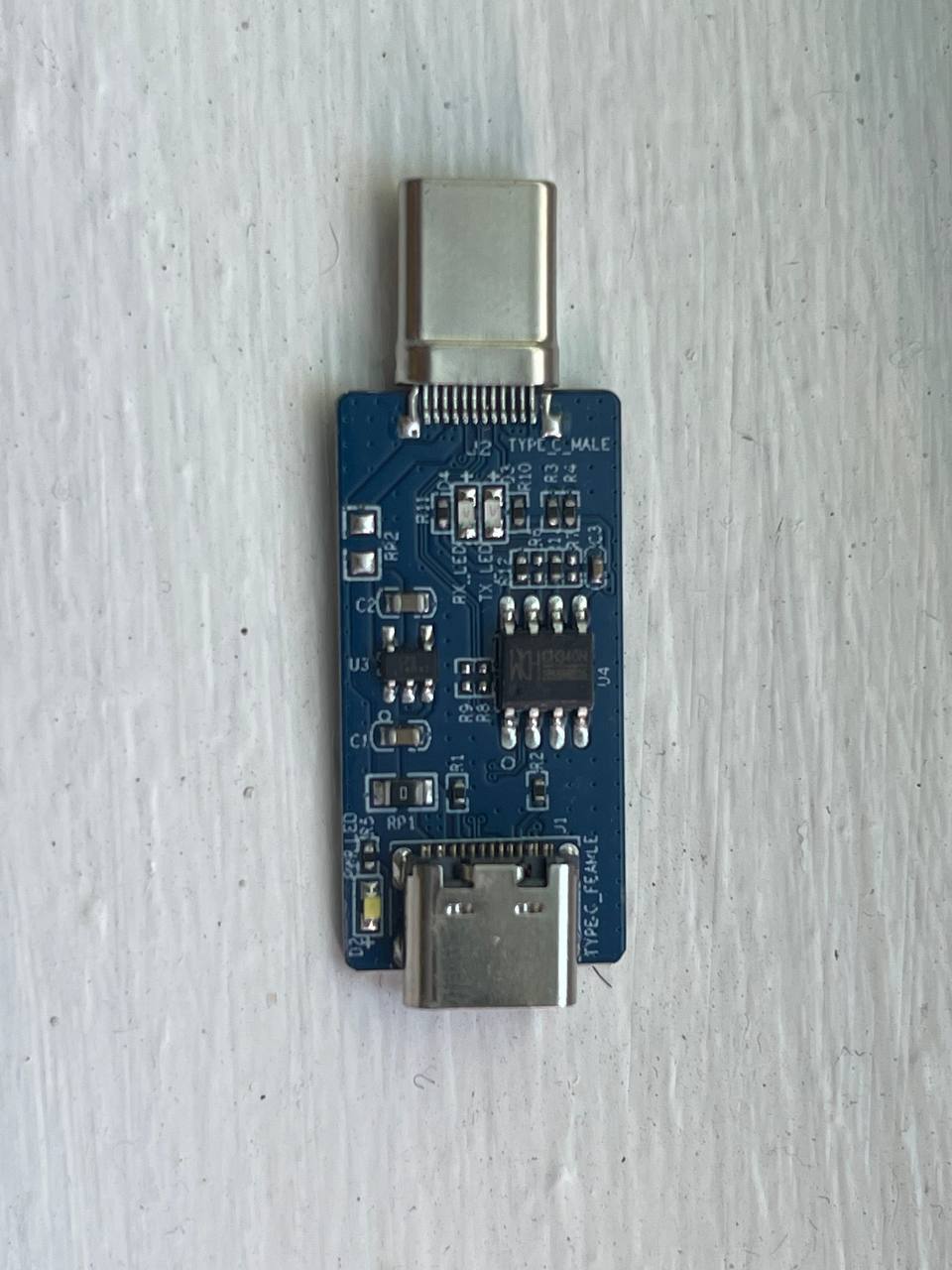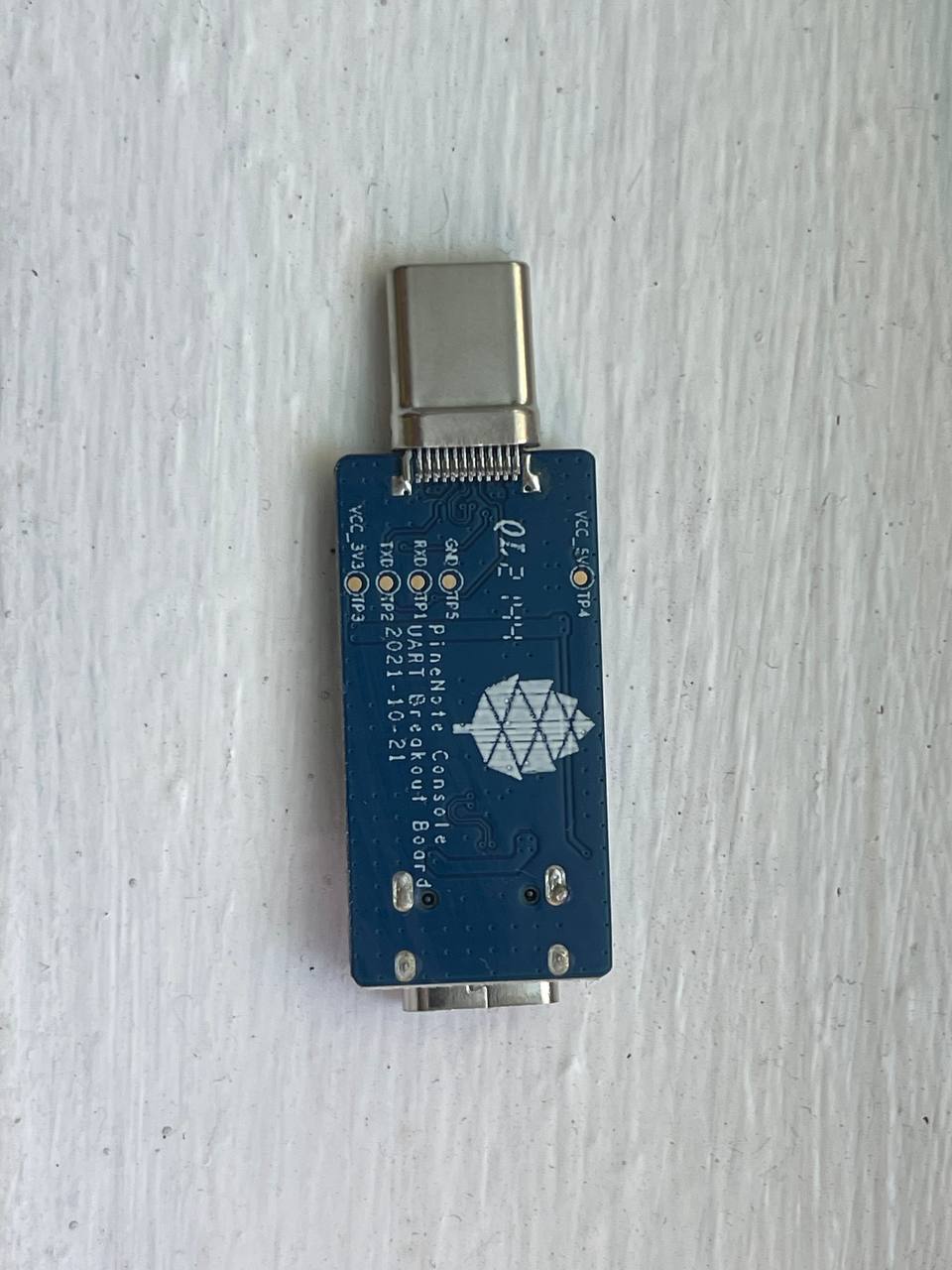Difference between revisions of "PineNote Development/UART"
m |
m (Added explanatory links to wikipedia) |
||
| Line 13: | Line 13: | ||
The UART dongle enables you to do this. | The UART dongle enables you to do this. | ||
The PineNote factory firmware runs UART at a baud rate of | The PineNote factory firmware runs UART at a baud rate of 1500000 bps, 8 data bits, 1 stop bit, no parity and no flow control. | ||
The process by which the PineNote design was modified to include closed-case UART is documented [[PineNote/Hardware Changes/Closed Case UART|here]]. | The process by which the PineNote design was modified to include closed-case UART is documented [[PineNote/Hardware Changes/Closed Case UART|here]]. | ||
| Line 33: | Line 33: | ||
# A USB-C breakout board with a male connector exposing the 24 pins of the PineNote's female USB-C port (located on the bottom of the device) | # A USB-C breakout board with a male connector exposing the 24 pins of the PineNote's female USB-C port (located on the bottom of the device) | ||
# A USB-UART adapter, to plug into a USB port of the computer you'll use to interface with the PineNote | # A USB-UART adapter, to plug into a USB port of the computer you'll use to interface with the PineNote | ||
# Jump wires to connect specific breakout board pins to pins on the USB-UART adapter | # [https://en.wikipedia.org/wiki/Jump_wire Jump wires] to connect specific breakout board pins to pins on the USB-UART adapter | ||
# Electrical tape to wrap connectors and prevent shorts | # Electrical tape to wrap connectors and prevent shorts | ||
| Line 53: | Line 53: | ||
Once you have acquired all necessary components, assemble the UART dongle as follows: | Once you have acquired all necessary components, assemble the UART dongle as follows: | ||
# Connect a jump wire from the GND pin on the USB-UART adapter to one of the four GND pins on the USB-C breakout board (A1, A12, B1, or B12) | # Connect a jump wire from the GND ([https://en.wikipedia.org/wiki/Ground_(electricity) ground]) pin on the USB-UART adapter to one of the four GND pins on the USB-C breakout board (A1, A12, B1, or B12) | ||
# Connect a jump wire from the RXD pin on the USB-UART adapter to the <code>UART2_RX_SUB2</code> pin on the USB-C breakout board (SBU2 aka B8) | # Connect a jump wire from the RXD pin on the USB-UART adapter to the <code>UART2_RX_SUB2</code> pin on the USB-C breakout board (SBU2 aka B8) | ||
# Connect a jump wire from the TXD pin on the USB-UART adapter to the <code>UART2_TX_SUB2</code> pin on the USB-C breakout board (SBU1 aka A8) | # Connect a jump wire from the TXD pin on the USB-UART adapter to the <code>UART2_TX_SUB2</code> pin on the USB-C breakout board (SBU1 aka A8) | ||
| Line 68: | Line 68: | ||
Once the hardware is connected, set up your computer's software as follows: | Once the hardware is connected, set up your computer's software as follows: | ||
# Install [https://www.gnu.org/software/screen/ GNU Screen] | # Install [https://www.gnu.org/software/screen/ GNU Screen] (or [https://askubuntu.com/q/40959 some other option], but the instructions below are written for <code>screen</code>) | ||
# Identify the USB-UART adapter in your <code>/dev</code> directory by running <code>ls /dev</code> with it plugged in, unplugging it, then again running <code>ls /dev</code> and seeing what changes; it is likely to be called <code>/dev/ttyUSB0</code> | # Identify the USB-UART adapter in your <code>/dev</code> directory by running <code>ls /dev</code> with it plugged in, unplugging it, then again running <code>ls /dev</code> and seeing what changes; it is likely to be called <code>/dev/ttyUSB0</code> | ||
# In a terminal window, run <code>screen -L /dev/ttyUSB0 1500000</code> (you may need to run this as sudo depending on your user's permissions) | # In a terminal window, run <code>screen -L /dev/ttyUSB0 1500000</code> (you may need to run this as sudo depending on your user's permissions) | ||
Revision as of 13:10, 12 October 2023
This page contains information on creating and using a UART dongle for the PineNote. The PineNote was shipped with a compatible UART dongle, but replacements are not available to order in case of loss or hardware fault. Thankfully it is not difficult to make your own from easily-acquired components.
A PineNote UART dongle enables you to:
- Interact with the system boot menu
- Read system events in real time as the PineNote is used
- Fix the PineNote without opening the case if something goes wrong while flashing it
Since the PineNote is an embedded system, interfacing with it during boot is more complicated than with an ordinary computer. The UART dongle enables you to do this.
The PineNote factory firmware runs UART at a baud rate of 1500000 bps, 8 data bits, 1 stop bit, no parity and no flow control. The process by which the PineNote design was modified to include closed-case UART is documented here.
Stock dongle
The stock UART dongle included with the PineNote was a simple device plugging directly into the PineNote's USB-C port. The dongle exposed a female USB-C port, which the user plugged into to get UART access. This design unfortunately ruled out passthrough USB connections, where the user connects to the PineNote via UART and USB simultaneously. The dongle is not currently available for purchase.
Creating a dongle
A PineNote UART dongle has four components:
- A USB-C breakout board with a male connector exposing the 24 pins of the PineNote's female USB-C port (located on the bottom of the device)
- A USB-UART adapter, to plug into a USB port of the computer you'll use to interface with the PineNote
- Jump wires to connect specific breakout board pins to pins on the USB-UART adapter
- Electrical tape to wrap connectors and prevent shorts
The PineNote's internal UART system is documented in this schematic.
USB-C pins are documented on the USB-C Wikipedia page; of the 24 pins, two are designated for "side band" use.
These pins are labeled SBU1 (A8) and SBU2 (B8).
In the PineNote UART schematic you can see (on the bottom right diagram) these pins are given the label UART2_TX_SUB1 and UART2_RX_SUB2 respectively.
The first (TX) is used for transmitting data and the second (RX) is used for receiving data.
These are the pins which must be exposed by the breakout board.
There are many possible USB-C breakout board designs available for purchase online. One particularly useful design is a "passthrough" or "intercept" style, with both male and female USB-C ports. This design is more versatile in case you want to reuse it in other projects, and also enables you to connect to the PineNote via UART and USB at the same time. An example of this product can be found here, although you are encouraged to shop around for cheaper options.
Similarly, there are many USB-UART adapter designs available. These devices plug into your computer and expose a number of pins themselves, connecting to specific pins on the breakout board with jump wires. Here is one example with jump wires included, although you are again encouraged to shop around for alternatives.
Once you have acquired all necessary components, assemble the UART dongle as follows:
- Connect a jump wire from the GND (ground) pin on the USB-UART adapter to one of the four GND pins on the USB-C breakout board (A1, A12, B1, or B12)
- Connect a jump wire from the RXD pin on the USB-UART adapter to the
UART2_RX_SUB2pin on the USB-C breakout board (SBU2 aka B8) - Connect a jump wire from the TXD pin on the USB-UART adapter to the
UART2_TX_SUB2pin on the USB-C breakout board (SBU1 aka A8)
Test that your system works by following the use instructions down below. Be very careful not to touch or short the pins while current is flowing through them - this can damage your device! Once you have confirmed that your UART dongle works, wrap all metal connectors in electrical tape to prevent accidental shorts.
Using UART
First, use your UART dongle to physically connect your PineNote to your computer:
- Plug the USB-UART adapter into one of your computer's USB ports
- Plug the USB-C breakout board into the USB-C port on the bottom of your PineNote; it is likely that the orientation matters, so try both and remember which one works
Once the hardware is connected, set up your computer's software as follows:
- Install GNU Screen (or some other option, but the instructions below are written for
screen) - Identify the USB-UART adapter in your
/devdirectory by runningls /devwith it plugged in, unplugging it, then again runningls /devand seeing what changes; it is likely to be called/dev/ttyUSB0 - In a terminal window, run
screen -L /dev/ttyUSB0 1500000(you may need to run this as sudo depending on your user's permissions)
Once the software is set up, power-cycle your PineNote; as the system boots you should see text appearing in your terminal window.
You can exit the screen session with ctrl+a k then pressing y to confirm.
The screen -L flag outputs a text log of the session to the current working directory, probably called screenlog.0.
Troubleshooting
If you don't see any text in your terminal as the PineNote boots, or the text is garbled, try the following:
- Ensure your GND, RX and TX jump wires are connected to the correct pins on both the USB-UART adapter and the USB-C breakout board
- Connect your USB-C breakout board to your PineNote in the opposite orientation
- Run the screen command as sudo in case your user doesn't have appropriate permissions
- Ensure you are setting the baud rate in the
screencommand to 1500000 (1.5 million)
USB passthrough
If your USB-C breakout board has a passthrough/intercept design, you can connect to your PineNote over USB and UART at the same time. This can be useful when you're doing development work on the PineNote boot process so you don't have to continually reconnect cables. You'll need a USB-A to USB-C cable, connecting directly from your computer's USB-A hub to your USB-C breakout board's female USB-C port. It's important to connect directly from USB-A, without any intermediate USB-C components. Note that connecting a live USB cable to your USB-C breakout board in this way dramatically increases the danger of frying your PineNote with a short, so you should only do this if all connectors are safely wrapped in electrical tape.


